Term of the Month: ChaalchitraFebruary 01, 2024 The art of chaalchitra design, particularly for Kali and Durga idols, has a rich and fascinating history deeply rooted in the cultural and religious traditions of India. It is called Chaalchitra because it is painted on the chaali, or roof/ covering of the idol. Many artists also refer to it as ‘Pat-lekha’ (writing, or marking on pat, referring to a background). Thus, it is also known as Durga Chala or Devichal. Chaalchitra typically refers to the intricate and symbolic designs that adorn the backdrops of the idols during the worship of Hindu deities, especially during festivals like Durga or Kali Puja. |
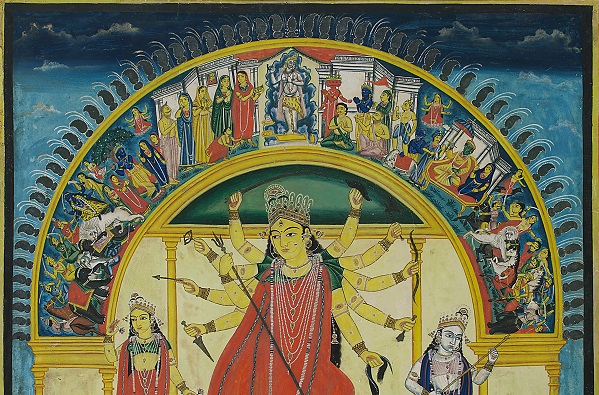
Unidentified Artist (Early Bengal School)
Untitled (detail)
Tempera highlighted with gold pigment on paper, late 19th century, 20.5 × 18.0 in.
Collection: DAG
|
The tradition of using chaalchitra in idol design can be traced back to ancient times when artisans and sculptors sought to enhance the visual appeal of religious icons. Even though chaalchitra designs are usually painted directly on circular or semi-circular backdrops, the sculptors would often make these designs themselves. The art form evolved over the centuries, incorporating various elements of mythology, symbolism, and cultural aesthetics. One of the most notable forms of chaalchitra is the patachitra, which originated in the rural areas of Bengal and continues to thrive as a vibrant art form today. Patachitra artists, known as 'patuas' or 'chitrakars', create elaborate narrative scrolls using natural pigments derived from minerals, plants, and other organic materials. These scrolls are often made on long strips of cloth or paper and are adorned with intricate details, vibrant colours, and stylised figures. |
|
Prahlad Karmakar Village Kali Puja Oil on canvas, 1938 Collection: DAG |
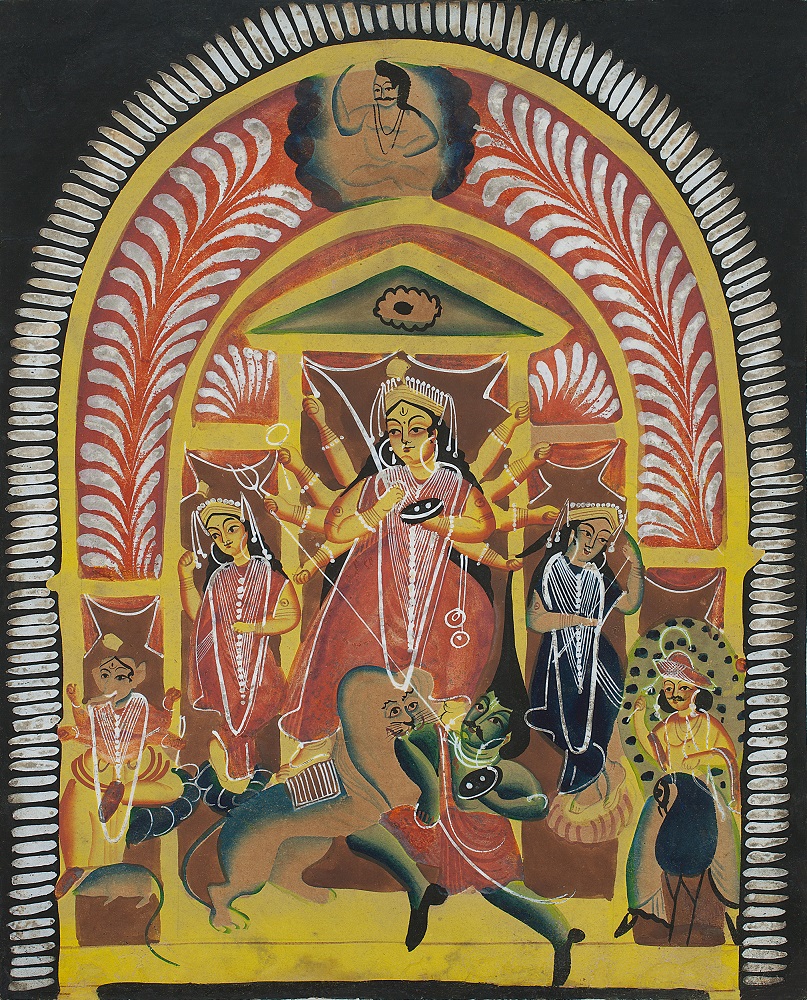
Unidentified Artist (Kalighat Pat)
Durga Festival Icon
Tempera and watercolour on paper, mid-19th century, 13.7 × 11.0 in.
Collection: DAG
In the case of Kali and Durga idols, the use of chaalchitra serves several purposes. Firstly, it provides a visually striking and vibrant background against which the deity is showcased. These designs often depict mythological stories, celestial scenes, or intricate patterns that add to the overall grandeur of the idol. The backdrop is not merely decorative but is also considered a sacred space, amplifying the divine presence during worship. The themes depicted in chaalchitra are deeply rooted in Hindu mythology. For Durga idols, scenes from the Devi Mahatmya or stories of the goddess's triumph over the demon Mahishasura are commonly portrayed. The intricate detailing in these designs reflects the artisan's mastery over their craft and their deep understanding of the religious narratives. |
|
In the case of Kali idols, the chaalchitra often showcases the goddess in her fierce form, adorned with skulls and weapons, standing over the defeated demon. The background may include representations of cosmic battles and divine interventions, adding a sense of drama and power to the overall composition. |
|
Chaalchitra design Image courtesy: Wikimedia Commons |
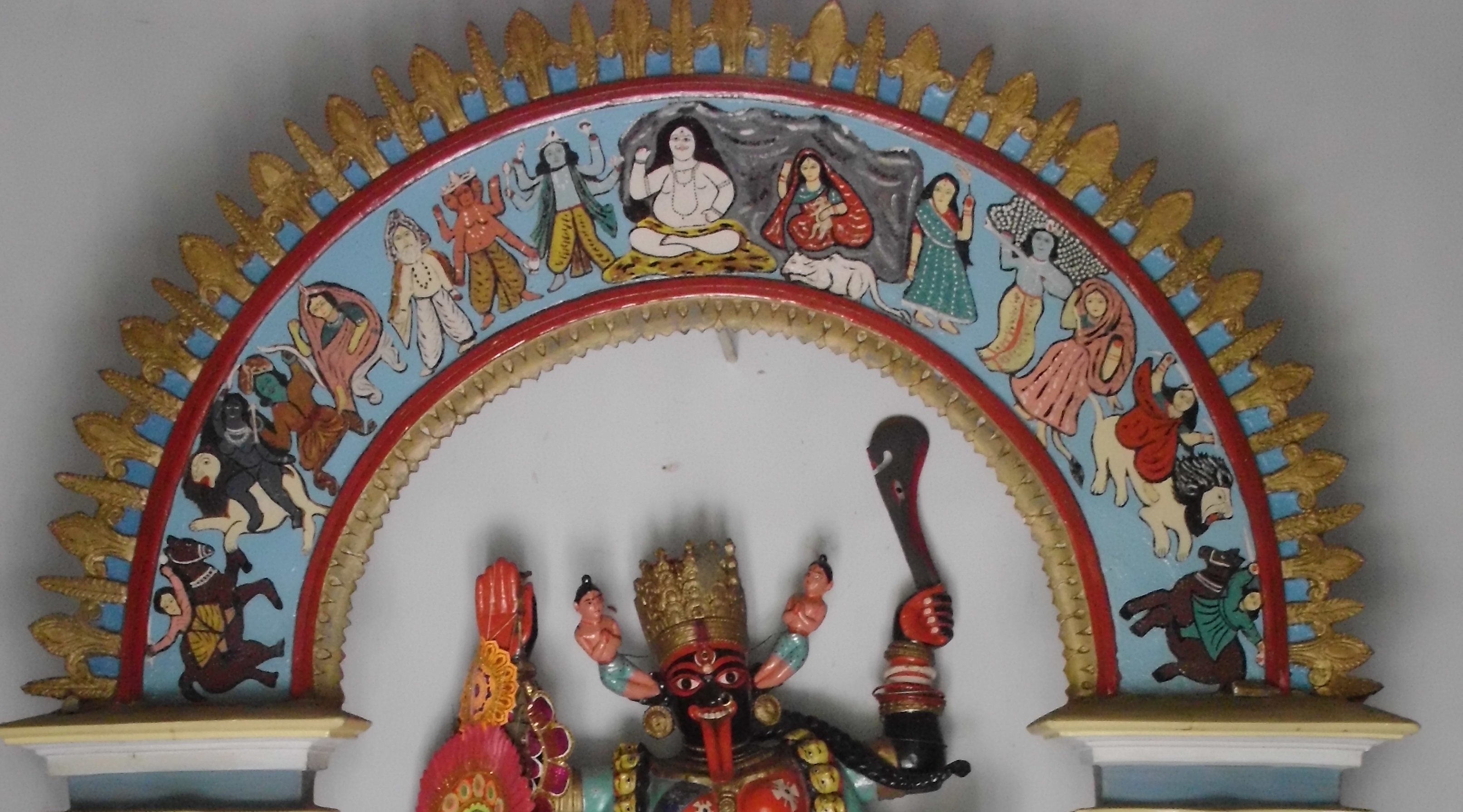
Chaalchitra design
Image courtesy: Wikimedia Commons
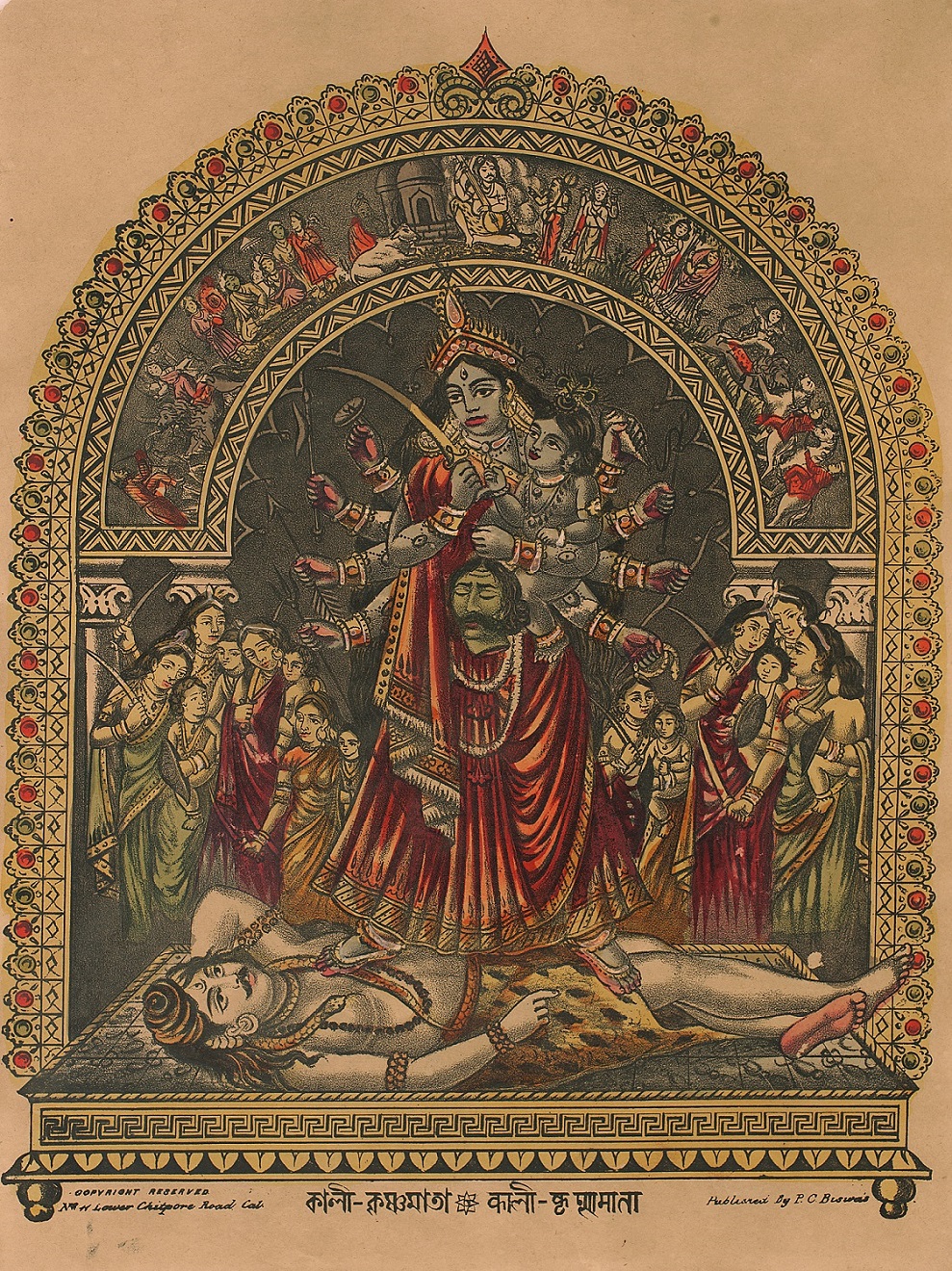
Unidentified Artist (Bengal Lithograph)
Kali-Krishnamata
Lithograph tinted with watercolour on paper, 19th century, 14.7 × 11.5 in
Collection: DAG
However, some historians have drawn our attention to the subtle ways in which temporal events were also figured into the imagery of chaalchitra design—from recognising specific patrons to celebrating familiar conquests over new territory or rival rulers. The shift in the popularity of motifs, from a predominantly animal-centric world to more anthropomorphic (albeit largely divine) icon-forms, also reflect a tendency to narrate human histories under terms of political and cultural patronage, according to historians like Sudhir Chakrabarti. |
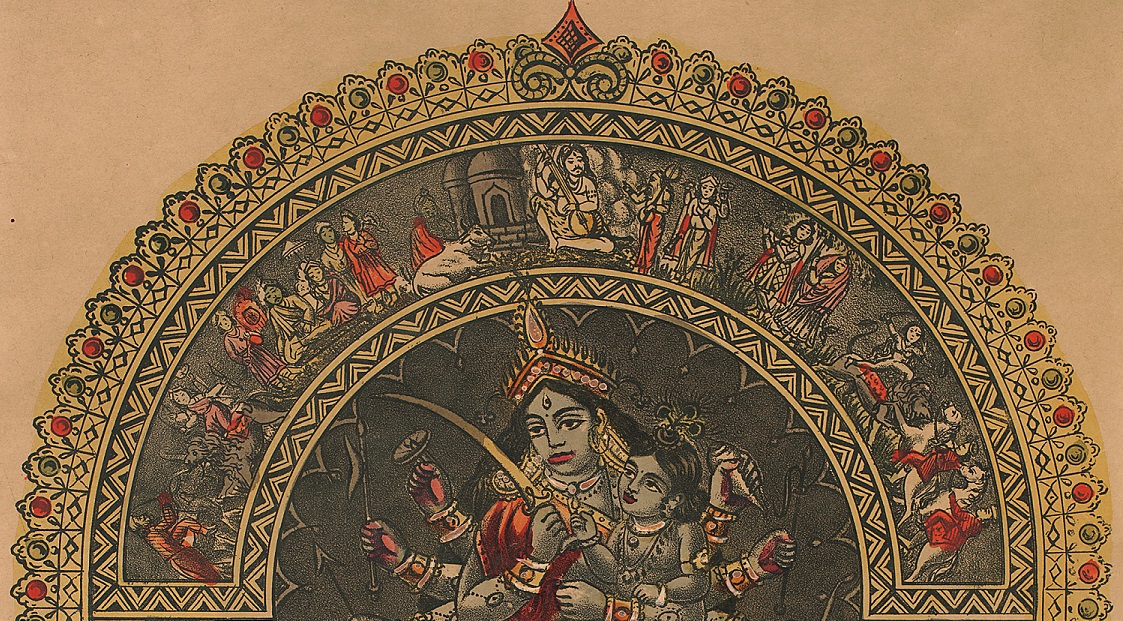
Unidentified Artist (Bengal Lithograph)
Kali-Krishnamata (detail)
Lithograph tinted with watercolour on paper, 19th century, 14.7 × 11.5 in
Collection: DAG
While remarking on the development of traditional puja imagery in Bengal, Sudhangshu K. Ray writes, ‘The first stage of the sculptural art of Puja is marked with god-heads. When developed further into the second stage, it began to record and illustrate important historical and political events that took place in the country from time to time. The main event we find, is depicted dramatically in three dimensionally modelled figures and (the) related story is drawn separately in a two-dimensional painting on the background called chalchitra, fixed invariably at the back and above the modelled images.’ |
|
Writing further about the regular themes in chaalchitra design, the same historian writes, ‘…the goddess Durga of the lion-clan kills the demon of the buffalo-clan in a fierce battle; the goddess Kali dominates over the fallen Emperor-god after the great slaughter of her foes; Lord Shiva, the Great-god, receives ‘free gifts’ of foodgrains from the goddess Annapurna at the time of a great famine in the country; these are the main themes that are adopted in modelling the foreground; and the corresponding histories are presented in painting as the background. Such composite images were originally invented to commemorate officially, and stabilize magically the conquest, coronations, marriage and other important event of life of a ruler-god, which continued afterwards in the rigid form of festival, or Puja. |
|
Unidentified Artist Durgadevi (detail) Oleograph on paper,14.2 × 9.7 in. Collection: DAG |
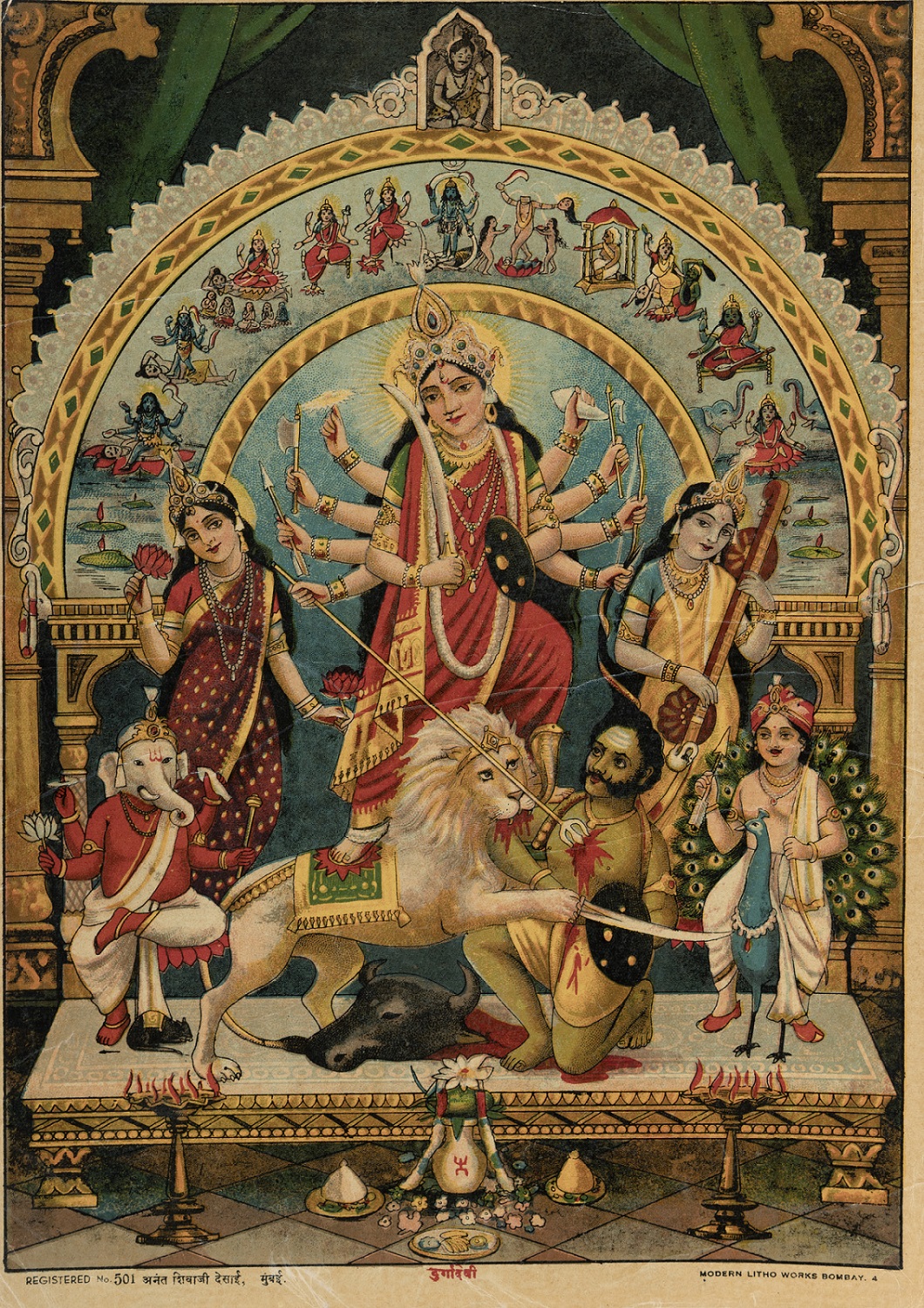
Unidentified Artist
Durgadevi (detail)
Oleograph on paper,14.2 × 9.7 in.
Collection: DAG
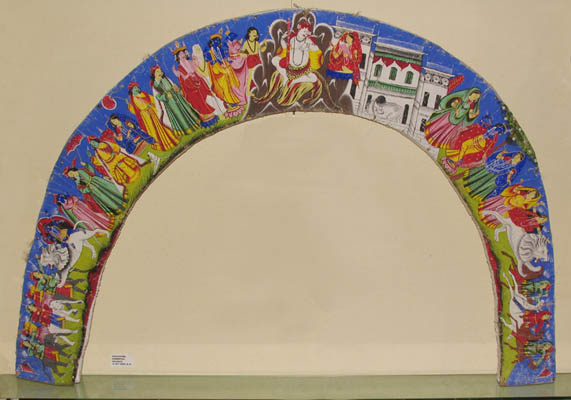
Chaalchitra design
Image courtesy: Wikimedia Commons
The materials used in creating chaalchitra have evolved over time. Traditionally, artisans used natural pigments, such as turmeric, vermillion, and indigo, along with organic binders to paint the images on a backcloth of stretched, usually mud-caked, canvas or thick cloth. A ground would usually be prepared with mud and chalk before painting. However, with technological advancements, artists now also employ synthetic colours and materials to achieve more intricate and long-lasting designs. Sometimes, the images may be painted before on paper and then pasted on the frame. There are usually three forms the chaalchitra can take, even though, as suggested earlier, the rounded, semi-circular arch is predominant. This is known as the ‘shaabek riti’ (the traditional method). The second form was popular at the Krishnanagar palace, which exceeded the breadth of the idols. The third type is made up of three vertices, used at the house festivals at the Pathuriaghata Tagore home or the Sabarna Roy Chowdhury estate. |
|
The tradition of chaalchitra design is not confined to a particular region but has spread across various parts of India where the worship of Durga and Kali holds significance. Different regions may showcase unique styles, influenced by local art and cultural nuances. In Bengal, Krishnanagar, Nabadwip and Santipur are held to be the most influential centres for chaalchitra artists. |
|
|
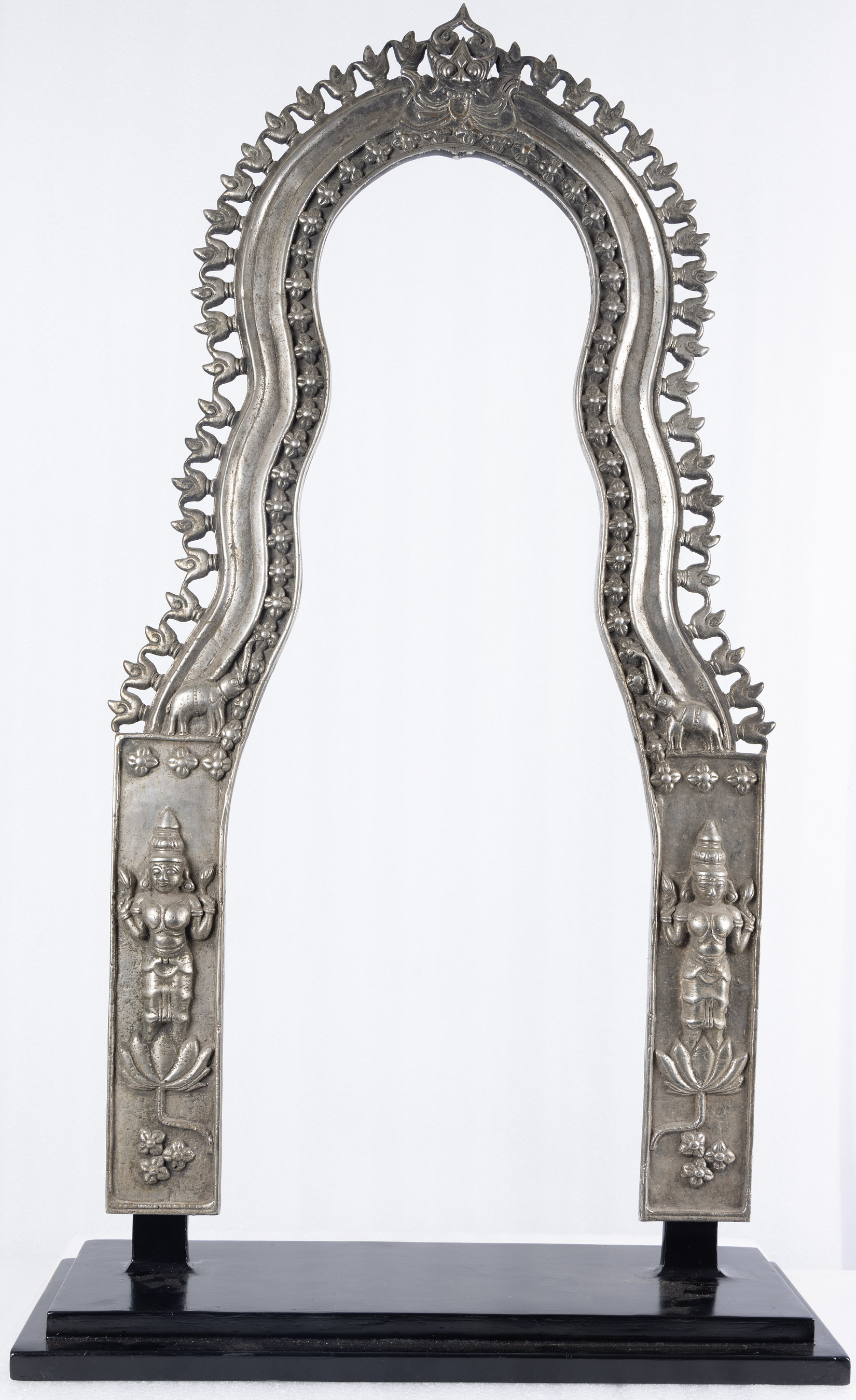
Unidentified Artist
Prabhavali
White metal, 1800s, 35.0 × 18.2 × 1.0 in.
Collection: DAG
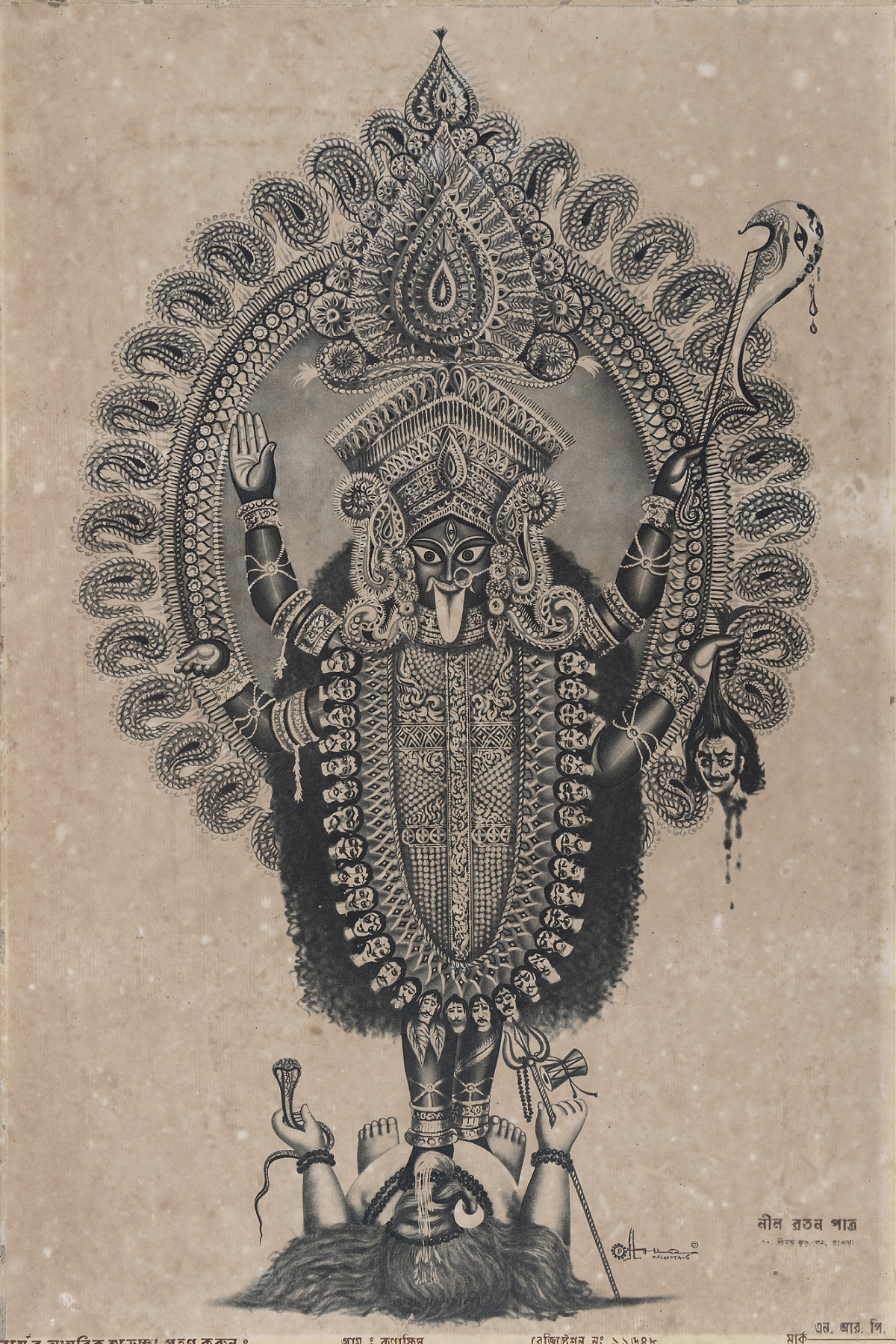
Unidentified Artist
Jai Maa Kali
Mechanical reproduction on paper pasted on cardboard, 23.7 × 15.7 in.
Collection: DAG
In temple traditions of Kerala and Tamil Nadu, the prabhavali may remind one of the chaalchitra. It serves as a radiant and ornate architectural frame encircling the primary deity, often Kali or Durga, in temples and religious settings. This elaborate structure not only highlights the central deity but also symbolizes divine energy and spiritual power. The term ‘Prabhavali’ derives from Sanskrit, where ‘Prabha’ means radiance or aura, and ‘Vali’ refers to a boundary or enclosure. Together, the prabhavali signifies an ethereal halo or aureole, encapsulating the deity with divine brilliance. Prabhavalis are crafted using various materials, including wood, metal, stone, and even precious metals like gold and silver, depending on the scale, budget, and artistic preferences of the artisans and patrons involved. Skilled craftsmen meticulously carve, cast, or sculpt these frames, infusing them with devotion, craftsmanship, and aesthetic beauty. Prabhavali designs include floral motifs and foliage, divine beings, celestial figures, mythological scenes and sacred geometries, including mandala-forms. |
|
Beyond their aesthetic appeal, Prabhavalis serve a deeper spiritual purpose, acting as a gateway to the divine realm and facilitating the devotee's communion with the deity. They create a sacred space within the temple or shrine, imbuing the surroundings with an aura of sanctity and transcendence. In contemporary times, the art of chaalchitra design has continued to thrive, with artisans blending traditional techniques with modern innovations. The designs not only serve religious and cultural purposes but have also become an essential aspect of the visual spectacle associated with festivals like Durga Puja, captivating devotees and tourists alike with their beauty and spiritual significance. |
|
Reddeppa Naidu Deity (detail) Oil on canvas laid on plywood, 1971,33.2 × 43.5 in. |
|
Further Reading:
|
|
Mukul Dey Maha Devi Ma Durga Drypoint on rice paper, 1974 9.7 × 7.7 in. Collection: DAG |


